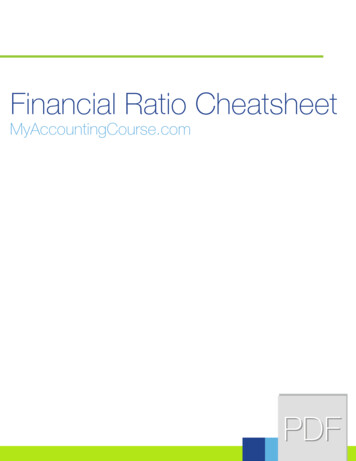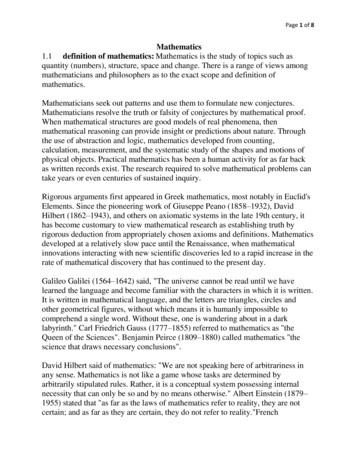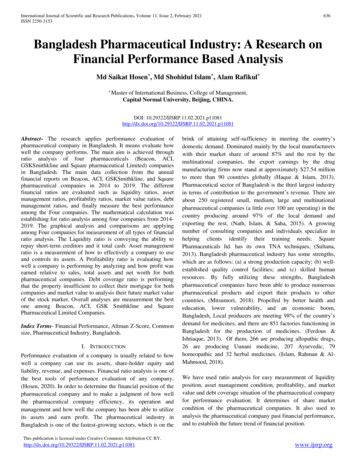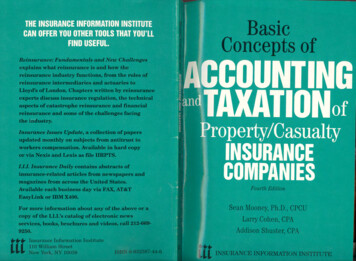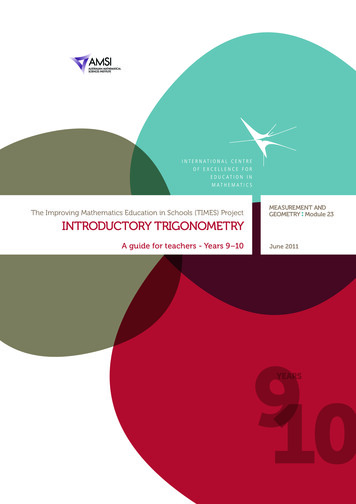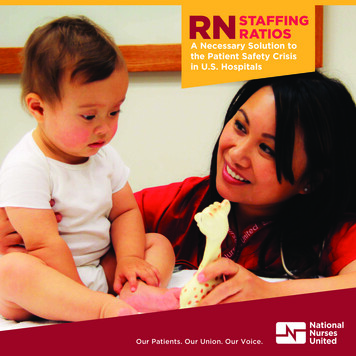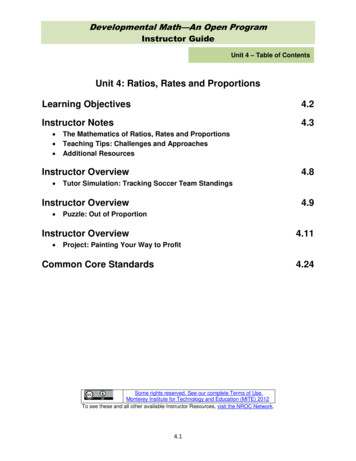
Transcription
Developmental Math—An Open ProgramInstructor GuideUnit 4 – Table of ContentsUnit 4: Ratios, Rates and ProportionsLearning Objectives4.2Instructor Notes4.3 The Mathematics of Ratios, Rates and ProportionsTeaching Tips: Challenges and ApproachesAdditional ResourcesInstructor Overview 4.8Tutor Simulation: Tracking Soccer Team StandingsInstructor Overview 4.9Puzzle: Out of ProportionInstructor Overview 4.11Project: Painting Your Way to ProfitCommon Core Standards4.24Some rights reserved. See our complete Terms of Use.Monterey Institute for Technology and Education (MITE) 2012To see these and all other available Instructor Resources, visit the NROC Network.4.1
Developmental Math—An Open ProgramInstructor GuideUnit 4 – Learning ObjectivesUnit 4: Ratios, Rates and ProportionsLesson 1: Ratio and RatesTopic 1: Simplifying Ratios and RatesLearning Objectives Write ratios and rates as fractions in simplest form. Find unit rates. Find unit prices.Lesson 2: ProportionsTopic 1: Understanding ProportionsLearning Objectives Determine whether a proportion is true or false. Find an unknown in a proportion. Solve application problems using proportions.4.2
Developmental Math—An Open ProgramInstructor GuideUnit 4 – Instructor NotesUnit 4: Ratios, Rates and ProportionsInstructor NotesThe Mathematics of Ratios, Rates and ProportionsThis unit introduces students to ratios. They'll learn to recognize and apply these numbers infamiliar situations and to describe them both verbally and symbolically. By the time theycomplete the unit, they'll be able to define, write, simplify, and evaluate ratios, rates, unit ratesand prices, and proportions.Teaching Tips: Challenges and ApproachesStudents all deal happily with ratios every single day, they just don't realize it. Once they learn afew definitions and techniques, put in some practice, and see how useful ratios are, this unitshould go smoothly for most of them.PreparationMuch of the work is an extension of the ideas and skills learned in Unit 2, Fractions and MixedNumbers. Before tackling ratios, make sure that students have mastered that material. Theemphasis on this unit should be the practical application of fractions.Recognizing RatiosStudents experience ratios all the time—they read speed limit signs on the way to school, theyhear commercials claiming that nine out of ten dentists prefer a particular type of toothpaste,and they figure out how much money they'll make working over the weekend. They just don'tcall these values ratios. Make that connection—use lots of examples and problems to show howordinary and everyday ratios are, and students will be more interested and comfortable inworking with them.Laying out all the different ways to write ratios will help students realize they've seen thembefore:4.3
Developmental Math—An Open ProgramInstructor Guide[From Lesson 1, Topic 1, Topic Text]It will also help to identify some of the key words and symbols that signal a ratio is at hand, suchas:perfor everyto/:Ratios vs. RatesStudents should pick up the concept of ratios easily—comparing two numbers is somethingthey've already done plenty of. But they may struggle a bit with rates. Many think that ratemeans speed, and at least at first, they'll be confused that prices or wages can also beexpressed as rates. Giving a clear definition of rate will help, as will more examples, like thefollowing:4.4
Developmental Math—An Open ProgramInstructor Guide[From Lesson 1, Topic 1, Worked Example 4]This shows students that rates compare two numbers measured in different units—to be a rate,all that matters is that the units are different.Be sure to point out that all rates are ratios but not all ratios are rates.Cross-multiplyingThis unit teaches students several new ideas and terms, but really only one fresh technique—cross-multiplication. Students are shown how to use it to decide if a proportion is true, and alsoto calculate an unknown, as seen below:4.5
Developmental Math—An Open ProgramInstructor Guide[From Lesson 2, Topic 1, Presentation]It is important to emphasize that cross-multiplying should be done only after checking that theunits are consistent. In fact, it’s important to stress that students must watch units carefullythroughout these lessons. It’s easy for them to focus so much on getting the numbers correctthat they forget to pay attention to the units. Make a point of checking units when workingthrough problems in the classroom.One word of warning: For whatever reason, students really like cross-multiplying. Theyremember learning this in elementary school and it sticks with them. Once they relearn thisskill, they may try to apply it where it shouldn’t be used, for example when multiplying or dividingtwo fractions.Keep In MindAs always, application problems should be used frequently. Show students explicitly how ratios,rates, and proportions are useful in everyday life. We've all stood indecisively in the grocerystore trying to figure out which package is the better buy:4.6
Developmental Math—An Open ProgramInstructor Guide[From Lesson 1, Topic 1, Topic Text]Additional ResourcesIn all mathematics, the best way to really learn new skills and ideas is repetition. Problemsolving is woven into every aspect of this course—each topic includes warm-up, practice, andreview problems for students to solve on their own. The presentations, worked examples, andtopic texts demonstrate how to tackle even more problems. But practice makes perfect, andsome students will benefit from additional work.A good website to review all the skills learned in this unit can be found t 4 teaches students the practical applications of ratios and proportions. They'll learn how towrite and simplify ratios, find unit rates and prices, and evaluate proportions. Because ratios arereally fractions, this material reinforces what was learned Unit 2: Fractions.4.7
Developmental Math—An Open ProgramInstructor GuideUnit 4 – Tutor SimulationUnit 4: Ratios, Rates and proportionsInstructor OverviewTutor Simulation: Tracking Soccer Team StandingsPurposeThis simulation allows students to demonstrate their understanding of ratios. Students will beasked to apply what they have learned to solve a problem involving: RatiosProportionsApplying Ratios and Proportions to Real-World SituationsProblemStudents are presented with the following problem:It's soccer season, and somebody is tracking team standings. Guess what . that somebody isyou.Enjoy the games.RecommendationsTutor simulations are designed to give students a chance to assess their understanding of unitmaterial in a personal, risk-free situation. Before directing students to the simulation, Make sure they have completed all other unit material.Explain the mechanics of tutor simulations.o Students will be given a problem and then guided through its solution by a videotutor;o After each answer is chosen, students should wait for tutor feedback beforecontinuing;o After the simulation is completed, students will be given an assessment of theirefforts. If areas of concern are found, the students should review unit materials orseek help from their instructor.Emphasize that this is an exploration, not an exam.4.8
Developmental Math—An Open ProgramInstructor GuideUnit 4 – PuzzleUnit XX: Ratios, Rates and proportionsInstructor OverviewPuzzle: Out of ProportionObjectivesOut of Proportion lets students see how well they understand ratios and proportions. In order tosucceed, they'll have to write a proportion based on a verbal description, and then calculate themissing value that will make the equation true.DescriptionThis puzzle is made up of 20 word problems. In each one, players are given enough informationto set up a proportion with one unknown value. Once they arrange the relationship correctly,4.9
Developmental Math—An Open ProgramInstructor Guidethey're asked to choose the value that will satisfy the proportion. Students can figure theanswers in their heads or on paper using the method they prefer, such as finding the equivalentfraction or cross-multiplying.Out of Proportion is suitable for both individual and group play. It could also be used in theclassroom to illustrate the horizontal and vertical symmetry of proportions.4.10
Developmental Math—An Open ProgramInstructor GuideUnit 4 – ProjectUnit 4: Ratios, Rates and ProportionsInstructor OverviewProject: Painting Your Way to ProfitStudent InstructionsIntroductionThere are numerous cases in which proportional reasoning helps to clarify thinking andilluminate the actual costs associated with doing business.TaskIn this project, your group will draft a plan for financing the start-up of your own paintingcompany. The owner of a local apartment complex is interested in hiring you to paint all of theapartments in his complex. By using proportional thinking, your group will minimize costs,determine the terms of a contract with the owner of the apartment complex, and make apresentation to the bank from which you will seek a loan.InstructionsSolve each problem in order and save your work as you progress, as you will create aprofessional presentation at the conclusion of the project.1. First problem: Make a trip to the local paint store or, alternatively you can shop online atwww.homedepot.com, which provides prices and specifications on paint products.You will be painting inside, so select a single brand of interior paint. Be sure that thepaint is sold in quarts, gallons, and 5-gallon sizes. Record the relevant information in the chart below. Use a proportion to determine thenumber of gallons in 1 quart, expressing your answer as a decimal. Note that thereare 4 quarts in 1 gallon. In the table below, record all the volumes in gallons. [Hint: To convert quarts to gallons, consider a proportion of the form1gxa logn.]a lo n s 4q1u aqr ut asr t 4.11
Developmental Math—An Open ProgramInstructor Guide Now compute the unit price of the paint. Be sure to justify the way in which youchose to compute the unit price and explain why it is the most relevant andinformative.[Hint: When computing unit prices, there are two ways to compute them dependingon whether you use the information on volume or coverage.]Information on Paint Purchase OptionsOption #1Option #2Option #3quart containergallon container5-gallon containerPriceVolume(in gallons)Coverage(in sq. ft.)Unit Price2. Second problem: You will now consider a simple scenario before attempting to calculate the cost of thepaint needed for the entire apartment complex. First, we will calculate the bestpurchase option for a wall that is 8 feet high and 12 feet long. Make a sketch anddetermine the area of this wall (length x height). From the information in your chart,determine whether to purchase paint in quarts (1, 2, or 3) or whether to purchase agallon.4.12
Developmental Math—An Open ProgramInstructor Guide Based on your proportional thinking, you suspect that the coverage listed on thecans is not correct. You reason that since the amount of coverage depends onvolume of paint in the can, the coverage amounts should be proportional. Determinewhether, for each option, the ratio of coverage to volume is the same. If two of theratios match and a third does not, determine the amount of coverage that wouldmake the coverage rates proportional. Does this new information change yourdecision to purchase paints in quarts (1, 2, or 3) or a gallon? With your new coverage amount(s), re-compute your unit prices and record the newresults in the table below.Information on Paint Purchase OptionsOption #1Option #2Option #3quart containergallon container5-gallon containerPriceVolume(in gallons)Coverage(in sq. ft.)Unit Price You decide to calculate the cost for various coverage areas using the unit prices. Fillin the tables below using the unit prices you found in the preceding (revised) table.Now determine the lowest cost for each coverage area.Cost Using QuartsCoverage Area4.13
Developmental Math—An Open ProgramInstructor Guide150 sq. ft.500 sq. ft.1500 sq. ft.Cost using unitpriceNumber of quartsneededActual Cost ofPaint PurchasedCost Using GallonsCoverage Area150 sq. ft.500 sq. ft.1500 sq. ft.Cost using unitpriceNumber of gallonsneededActual Cost ofPaint PurchasedCost Using 5-Gallon CansCoverage Area150 sq. ft.500 sq. ft.Cost using unitpriceNumber of 5-galloncansActual Cost ofPaint Purchased4.141500 sq. ft.
Developmental Math—An Open ProgramInstructor Guide You discover that unit cost is not the only consideration when calculating the cost ofa job. With this new information, your group needs to make a plan for purchasingpaint. In the table below, there are various coverage areas. For each, determine twodifferent purchase options using combinations of quarts, gallons, and/or 5-galloncans. You should determine which option results in the least cost for each coveragearea. Remember to use the numbers from the Revised Information on PaintPurchase Options for your calculations.Paint Purchase PlanCoverage Area(sq. ft.)Purchase Option#1Purchase Option#2(dollars)(dollars)Least Cost(dollars)150 sq. ft.250 sq. ft.500 sq. ft.800 sq. ft.1500 sq. ft.3. Third Problem: Next, your group will determine the cost of painting walls in one apartment in thecomplex. They are studio apartments (one large room) that are 33 feet by 15 feetand have 8-foot high walls. So, there are two walls that are 33 feet by 8 feet and twowalls that are 15 feet by 8 feet. Make a sketch of each wall and calculate its area. Based on your group’s previous plan, determine the best paint purchase option forthis apartment. Calculate the actual cost of painting one apartment. Your groupshould make sure that your plan produces the lowest priced option for purchasingpaint. Remember to use the numbers from the Revised Information on PaintPurchase Options for your calculations.4.15
Developmental Math—An Open ProgramInstructor Guide4. Fourth problem: Your group will estimate the cost of painting 3 apartments in the complex. Adjustingyour plan from Problem 2 above, determine the least cost for paint needed. Next, determine the amount of labor needed for the job. Your group will assume fourpeople can paint three apartments per eight-hour day and that you are paying eachof them 10 per hour. Therefore, based on your paint price and cost for labor, compute the total amountyour group would charge the owner for the three-apartment job. Finally, your group will estimate the cost of painting the entire apartment complex,which contains 174 studio apartments. You will use this information to determine theterms of your agreement with the owner and make a presentation to a bank for astart-up loan for your painting company.[Hint: You may want to use a proportion for this problem, such as 3 ? .] x a1 p7 a4 rt a mpa erntt msentsYour group will need to purchase paint up front to begin the job – before you receiveany payment from the owner. You plan to ask the bank for a 1,000 start-up loan.Determine the number of apartments you could paint with that start-up money,before you would need to ask the owner for a partial payment, which you would thenuse to purchase more paint.[Hint: You may want to use a proportion for this problem, such as 3? a xp]1 0 0 0 t e mna ar pt am rtes ntsCollaboration Get together with another group to compare your answers to each of the four problems.Discuss how your group decided to purchase paint and explain your plan. Some groups mayhave chosen to go with extra paint, while some may have chosen to purchase exactly the paintthey needed. What if you were able to obtain a profit from painting an apartment? What would bea reasonable amount to charge per apartment?Would that change how many apartments you are able to complete with your start-upmoney?What elements are missing from the plan?4.16
Developmental Math—An Open ProgramInstructor Guide Do some Internet research to determine how much extra you may need formiscellaneous items. Include your extras in the final presentation.ConclusionsYour final presentation will be a professional analysis and report of the job to present to thebank in order to make your case in applying for the start-up loan. It should be in a binder orfolder that will be presented to a bank. It should include all of the mathematics used to solve thefour problems above. You may either neatly write out the tables and draw the studio apartmentor use software such as Microsoft Word to create a professional computer-generated product.You may want to use headings to separate your plan into two parts: Labor and Materials.Instructor NotesAssignment ProceduresProblem 1In the table below are data obtained on Glidden paint from Home Depot. The relevant unit priceis in square feet per area of coverage. PLEASE NOTE THAT ALL SUBSEQUENT ANSWERSWE CALCULATE ARE BASED ON THIS DATA. If students use different data, their answerswill of course vary from that given, but the overall results should be comparable.]Information on Paint Purchase OptionsOption #1Option #2Option #3quart containergallon container5-gallon container 9.97 21.97 99Volume(ingallons).25 gallons1 gallon5 gallonsCoverage(insq. ft.)150 sq. ft.350 sq. ft.1750 sq. ft.Unit Price0.066 dollars/sq. ft.0.063 dollars/sq.ft.0.057 dollars/sq. ft.PriceProblem 24.17
Developmental Math—An Open ProgramInstructor GuideThe wall would be 8 ft. x 12 ft. 96 sq. ft. Since this is less than the coverage for a quart, wewould purchase a quart of paint.The coverage amounts are not proportional, and in general the coverage amounts listed onquarts of paint are not proportional to those listed on gallons or 5-gallon containers. (Onereason for this is that the expectation is that those ordering quarts will be painting trim and notwalls, and walls generally absorb more paint than does trim.) Coverage estimates for quartsusually range from 100 - 150 sq. ft., and the numbers chosen in Problem #2 above wouldindicate a purchase of only one quart if the coverage were at or above 100 sq. ft. but two quartsif the coverage is less. However, two quarts cost almost as much as a gallon in most cases.Information on Paint Purchase OptionsPriceOption #1Option #2Option #3quart containergallon container5-gallon container 21.97 991 gallon5 gallons350 sq. ft.1750 sq. ft.0.063 dollars/sq.ft.0.057 dollars/sq. ft. 9.97Volume.25 gallons(in gallons)Coverage(in sq. ft.)87.5 sq. ft.Unit Price0.114dollars/sq. ft.4.18
Developmental Math—An Open ProgramInstructor GuideHere are the calculations, when done in unit price per unit of coverage. The lowest cost for the150 sq. ft. area is 19.94 (quarts), for the 500 sq. ft. area is 43.94 (gallons) and for the 1500sq. ft. area is 99.00 (5-gallon can).Cost Using QuartsCoverage Area150 sq. ft.500 sq. ft.1500 sq. ft.Cost using unitprice150 sq. ft. x 0.114dollars/sq. ft. 17.10500 sq. ft. x 0.114dollars/sq. ft. 57.001500 sq. ft. x 0.114dollars/sq. ft. 171.00Number of quartsneeded2 qts.6 qts.18 qts.Actual Cost of PaintPurchased 9.97 x 2 19.94 9.97 x 6 59.82 9.97 x18 179.46Cost Using GallonsCoverage Area150 sq. ft.500 sq. ft.1500 sq. ft.Cost using unitprice150 sq. ft. x 0.063dollars/sq. ft. 9.45500 sq. ft. x 0.063dollars/sq. ft. 31.501500 sq. ft. x 0.063dollars/sq. ft. 94.50Number of gallons1 gal.2 gal.5 gal.Actual Cost ofPaint Purchased 21.97 x 1 21.97 21.97 x 2 43.94 21.97 x5 109.854.19
Developmental Math—An Open ProgramInstructor GuideCost Using 5-Gallon CansCoverage Area150 sq. ft.500 sq. ft.1500 sq. ft.Cost using unitprice150 sq. ft. x 0.057dollars/sq. ft. 8.55500 sq. ft. x 0.057dollars/sq. ft. 28.501500 sq. ft. x0.057dollars/sq. ft. 85.50Number of 5-galloncans1 can1 can1 canActual Cost ofPaint Purchased 99.00 x 1 99.00 99.00 x 1 99.00 99.00 x 1 99.00Below are some purchase options, including the least purchase option for each coverage areausing the Glidden data from Home Depot.Paint Purchase PlanPurchase Option#1Purchase Option#2(dollars)(dollars)150 sq. ft.2 quarts @ 9.97 19.941 gal. @ 21.97 21.972 quarts for 19.94250 sq. ft.3 quarts @ 9.97 29.911 gal. @ 21.97 21.971 gal. for 21.97500 sq. ft.1 gal. @ 21.97and 2 quarts @ 9.97 41.912 gal. @ 21.97 43.941 gal. and 2 quartsfor 41.91800 sq. ft.2 gal. @ 21.97and 2 quarts @ 9.97 63.883 gal. @ 21.97 65.912 gal. and 2 quartsfor 63.881500 sq. ft.4 gal. @ 21.97and 2 quarts @ 9.97 107.825 gal. @ 99.00 99.005 gal. for 99.00Area Needed toCover (sq. ft.)4.20Least Cost(dollars)
Developmental Math—An Open ProgramInstructor GuideProblem 3The total area is (33 feet x 8 feet x 2 walls) (15 feet x 8 feet x 2 walls) 768 sq. ft. The leastcost will be obtained from 2 gallons and 1 quart for a total cost of 53.91.Problem 4The total coverage area is 768 sq. ft. per apartment x 3 apartments 2,304 sq. ft. The least costoption for this job will be 142.94 (one 5-gallon can and 2 gallons). Student answers may bedifferent if they did not use the Glidden data from Home Depot.4 people x 8 hours x 10 per hour 320.00The total cost for the three-apartment job would be labor paint 320.00 142.94 462.94.The total cost for the three-apartment job would be labor paint 320.00 142.94 462.94.The ratio problem of ? xcan be solved to obtain a cost of 3 apartments 174 apartments 26,850.52. Student’s answers may vary depending on whether they used the data from HomeDepot and on what choice they made for the lowest cost option for the three-room apartmentjob.Solving the ratio problem with ? 462.94 gives x 6.48 apartments. So, we could paint 6apartments before asking the owner for the first partial payment.Recommendations Have students work in teams to encourage brainstorming and cooperative learning.Assign a specific timeline for completion of the project that includes milestone dates.Provide students feedback as they complete each milestone.Ensure that each member of student groups has a specific job.Technology IntegrationThis project provides abundant opportunities for technology integration, and gives students thechance to research and collaborate using online technology. The students’ instructions listseveral websites that provide information on numbering systems, game design, and graphics.The following are other examples of free Internet resources that can be used to support thisproject:http://www.moodle.orgAn Open Source Course Management System (CMS), also known as a Learning ManagementSystem (LMS) or a Virtual Learning Environment (VLE). Moodle has become very popular4.21
Developmental Math—An Open ProgramInstructor Guideamong educators around the world as a tool for creating online dynamic websites for eachers or http://pbworks.com/content/edu overviewAllows you to create a secure online Wiki workspace in about 60 seconds. Encourageclassroom participation with interactive Wiki pages that students can view and edit from anycomputer. Share class resources and completed student work with parents.http://www.docs.google.comAllows students to collaborate in real-time from any computer. Google Docs provides freeaccess and storage for word processing, spreadsheets, presentations, and surveys. This isideal for group projects.http://why.openoffice.org/The leading open-source office software suite for word processing, spreadsheets,presentations, graphics, databases and more. It can read and write files from other commonoffice software packages like Microsoft Word or Excel and MacWorks. It can be downloadedand used completely free of charge for any purpose.RubricScoreContent 4 Presentation/CommunicationThe solution shows a deep understanding ofthe problem including the ability to identifythe appropriate mathematical concepts andthe information necessary for its solution.The solution completely addresses allmathematical components presented in thetask.The solution puts to use the underlyingmathematical concepts upon which the taskis designed and applies proceduresaccurately to correctly solve the problemand verify the results.Mathematically relevant observations and/orconnections are made.4.22 There is a clear, effective explanationdetailing how the problem is solved.All of the steps are included so thatthe reader does not need to inferhow and why decisions were made.Mathematical representation isactively used as a means ofcommunicating ideas related to thesolution of the problem.There is precise and appropriate useof mathematical terminology andnotation.Your project is professional lookingwith graphics and effective use ofcolor.
Developmental Math—An Open ProgramInstructor Guide 3 2 1 The solution shows that the student has abroad understanding of the problem and themajor concepts necessary for its solution.The solution addresses all of themathematical components presented in thetask.The student uses a strategy that includesmathematical procedures and somemathematical reasoning that leads to asolution of the problem.Most parts of the project are correct withonly minor mathematical errors.The solution is not complete indicating thatparts of the problem are not understood.The solution addresses some, but not all ofthe mathematical components presented inthe task.The student uses a strategy that is partiallyuseful, and demonstrates some evidence ofmathematical reasoning.Some parts of the project may be correct,but major errors are noted and the studentcould not completely carry out mathematicalprocedures.There is no solution, or the solution has norelationship to the task.No evidence of a strategy, procedure, ormathematical reasoning and/or uses astrategy that does not help solve theproblem.The solution addresses none of themathematical components presented in thetask.There were so many errors in mathematicalprocedures that the problem could not besolved.4.23 There is a clear explanation.There is appropriate use of accuratemathematical representation.There is effective use ofmathematical terminology andnotation.Your project is neat with graphicsand effective use of color.Your project is hard to followbecause the material is presented ina manner that jumps around betweenunconnected topics.There is some use of appropriatemathematical representation.There is some use of mathematicalterminology and notation appropriateto the problem.Your project contains low qualitygraphics and colors that do not addinterest to the project.There is no explanation of thesolution, the explanation cannot beunderstood or it is unrelated to theproblem.There is no use or inappropriate useof mathematical representations (e.g.figures, diagrams, graphs, tables,etc.).There is no use, or mostlyinappropriate use, of mathematicalterminology and notation.Your project is missing graphics anduses little to no color.
Developmental Math—An Open ProgramInstructor GuideUnit 4 – Correlation to Common CoreStandardsLearning ObjectivesUnit 4: Ratios, Rates and ProportionsCommon Core StandardsUnit 4, Lesson 1, Topic 1: Simplifying Ratios and RatesGrade: 8 - Adopted 2010Mathematical PracticesSTRAND / DOMAINCC.MP.8.CATEGORY / CLUSTERMP.8.3.STRAND / DOMAINGrade: 9-12 - Adopted 2010CC.MP.Mathematical PracticesCATEGORY / CLUSTERMP-3.Construct viable arguments and critique the reasoning ofothers.Construct viable arguments and critique the reasoning ofothers.Unit 4, Lesson 2, Topic 1: Understanding ProportionsGrade: 8 - Adopted 2010Mathematical PracticesSTRAND / DOMAINCC.MP.8.CATEGORY / CLUSTERMP.8.3.STRAND / DOMAINGrade: 9-12 - Adopted 2010CC.MP.Mathematical PracticesCATEGORY / CLUSTERMP-3.Construct viable arguments and critique the reasoning ofothers.Construct viable arguments and critique the reasoning ofothers.4.24
Make a trip to the local paint store or, alternatively you can shop online at www.homedepot.com, which provides prices and specifications on paint products. You will be painting inside, so select a single brand of interior paint. Be sure that the paint is sold in quarts, gallons, and 5-gallon sizes.


